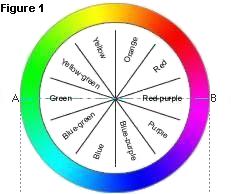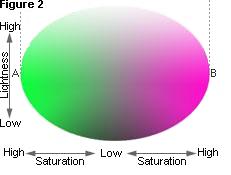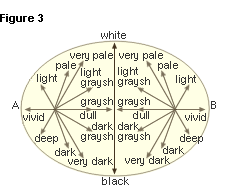Precise Color Communication
 |
   |
Apples are red, lemons are yellow, the sky is blue; that's how we all think of color in everyday language.
Hue is the term used in the world of color for the classifications of red, yellow, blue, etc.
Also, although yellow and red are two completely different hues, mixing yellow and red together results
in orange (which is sometimes referred to as yellow-red), mixing yellow and green results in yellow-green,
mixing blue and green results in blue-green, and so on. The continuum of these hues results
in the color wheel shown in Figure 1.
Colors can be separated into bright and dark colors when their lightnesses (how bright they are) are compared.
Take, for example, the yellows of a lemon and a grapefruit.
Without a doubt, the yellow of the lemon is much brighter.
How about the yellow of a lemon and the red of a sweet cherry.
Again, the yellow of the lemon is brighter, right? This lightness can be measured independently of hue.
Now take a look at Figure 2. This figure is a cross-section of Figure 1,
cut along a straight line between A (Green) and B (Red-purple). As the figure shows,
lightness increases toward the top and decreases toward the bottom.
Going back to yellow, how do you compare the yellows of a lemon and a pear?
You might say the yellow of the lemon is brighter, but more to the point in this case,
it is vivid, while the yellow of the pear is dull. This is another big difference,
but this time one of color saturation or vividness.
This attribute is completely separate from those of both hue and lightness.
If we look at Figure 2 again, we can see that saturation changes for red-purple and green respectively
as the horizontal distance from the center changes. Colors are dull near the center and become more vivid
as we move away from the center. Figure 3 shows general adjectives used to describe the lightness
and saturation of colors. To see what the words express, look back at Figure 2 again.
|
| 4/13 | ||
|
|

